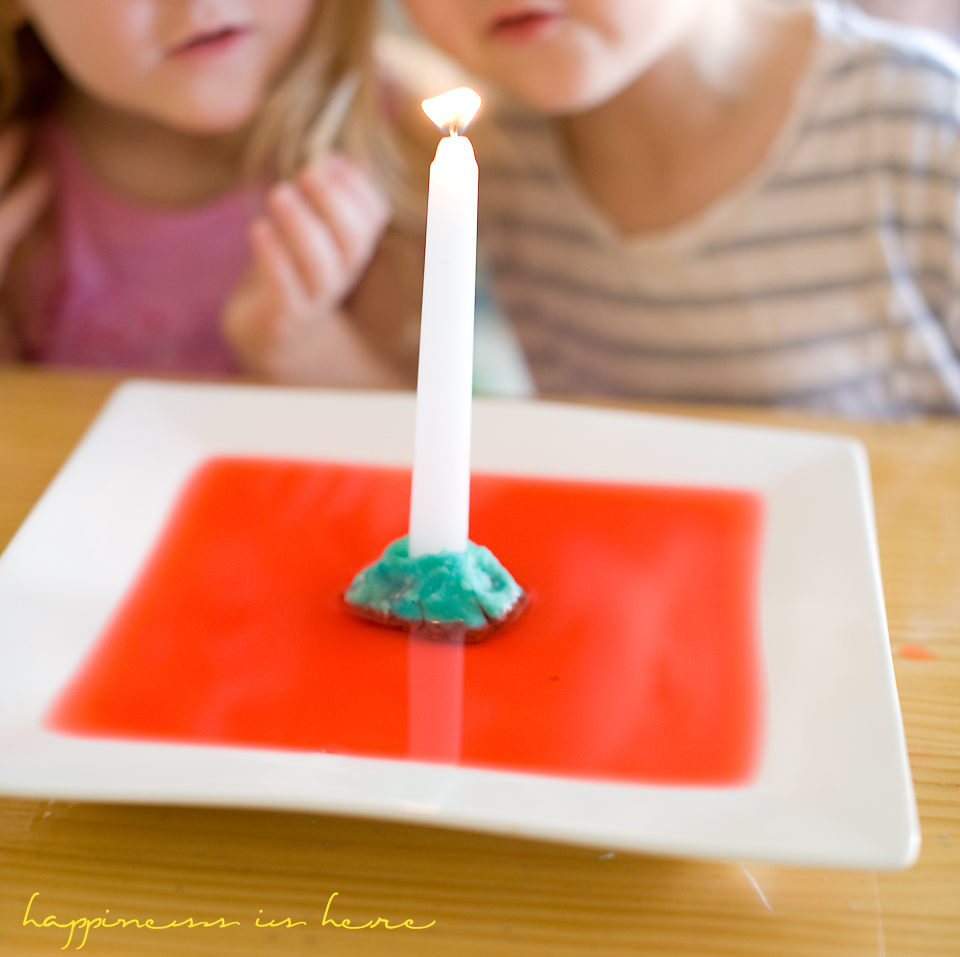
Science experiment: What’s in the air?
A few days ago my 3 year old was flipping through a new book of experiments. We are lucky to have family members who are always on the lookout for things that might be useful to us! This book came from the girls Aunty who is a teacher and sometimes gives us old library books from her school that are going to be thrown away. We have gotten some great books this way! This one has hundreds of simple experiments. We just happened to have all the materials for the one that caught my 3 year old’s eye. The experiment was called ‘What’s in the air?’ and all we needed was a plate, candle, matches, play dough, a jar, and some coloured water.
 The first step was to use the play dough to stand the candle up in the middle of the plate.
The first step was to use the play dough to stand the candle up in the middle of the plate.
 They then poured the coloured water into the plate around the candle.
They then poured the coloured water into the plate around the candle.
 Next, my job, lighting the candle. We talked about fire and that it needed oxygen to stay alight. They know what oxygen is because we have been learning about the body and talking about how our bodies use oxygen.
Next, my job, lighting the candle. We talked about fire and that it needed oxygen to stay alight. They know what oxygen is because we have been learning about the body and talking about how our bodies use oxygen.
 I then asked them what would happen when we put the jar over the top of the candle. They both said the candle would go out. When I asked them why my 5 year old was able to tell me that it was because there would be no oxygen for the fire. We put the jar over the top to see if she was right.
I then asked them what would happen when we put the jar over the top of the candle. They both said the candle would go out. When I asked them why my 5 year old was able to tell me that it was because there would be no oxygen for the fire. We put the jar over the top to see if she was right.
 After a few seconds the candle went out. They were so focused on that, that they didn’t notice anything else happening.
After a few seconds the candle went out. They were so focused on that, that they didn’t notice anything else happening.
 I finally asked them if they noticed anything else had changed and they discovered that some of the water had been sucked up into the jar!
I finally asked them if they noticed anything else had changed and they discovered that some of the water had been sucked up into the jar!
 I asked them why this happened and there were lots of guesses… ‘the jar sucked it up’, ‘ the candle sucked it up into the jar’, ‘the oxygen went out and the water went in’. I asked them where the oxygen went, which prompted them to remember that the oxygen gets used up by the fire. Then I explained that because the oxygen was gone the water moved up into the jar to fill the space left by the oxygen, and that it didn’t fill the whole jar because air is also made up of nitrogen and other gasses. They were fascinated! We have been talking about oxygen in the air and how it travels in our blood to different parts of our body, but it was hard to imagine for a 5 and a 3 year old because it’s not something you can actually see. I think this little experiment really helped them visualise what we had been talking about. A great coincidence that the experiment she had picked could be linked back to something we had been learning about.
I asked them why this happened and there were lots of guesses… ‘the jar sucked it up’, ‘ the candle sucked it up into the jar’, ‘the oxygen went out and the water went in’. I asked them where the oxygen went, which prompted them to remember that the oxygen gets used up by the fire. Then I explained that because the oxygen was gone the water moved up into the jar to fill the space left by the oxygen, and that it didn’t fill the whole jar because air is also made up of nitrogen and other gasses. They were fascinated! We have been talking about oxygen in the air and how it travels in our blood to different parts of our body, but it was hard to imagine for a 5 and a 3 year old because it’s not something you can actually see. I think this little experiment really helped them visualise what we had been talking about. A great coincidence that the experiment she had picked could be linked back to something we had been learning about.
Of course after this we repeated the experiment 6 more times. They really enjoyed it!





Comments
Very cool! My kids would love this
Very nice, thanks for sharing!
I hate to say this but I’m afraid your books explanation is wrong. I learnt this experiment as a great way to challenge kids thinking because everyone thinks it’s the oxygen first. Try it again and look at the rim of the jar you should see some bubbles escaping while the candle is alight. Also notice when the water comes up, after the candle goes out not while it’s lit. This is because the candle warms the air making it expand some is lost from the bottom of the jar, when the candle goes out the air cools and contracts and water is sucked up to replace the air that was lost.
Sorry to be a pedant, I can’t quite help it! I love your blog such beautiful pictures
Ha! Thank you, that’s interesting. I’m not sure though. The water started being sucked up straight away! Now I’m confused lol
Firstly thanks for your nice experiment. I will try it with my kid too. However, as a scientist I quite agree with Claire’s comment. When O2 is used, the CO2 is produced. So O2 is replaced by CO2 and some water as a result of oxidation process. The froce that suck the water in is hence due to the contraction of cooler air. The effect can be quick.
If you want to prove it, you can put very hot water in the bottle and the pour it away. Then quickly turn the bottle upside down on water. It should give the same effect. Well I will try both experiments with my kid now. It gives me so much thought!! Thank you
Explained by the law of conservation of matter.
I’d like a simple experiment to convince a cognatively impaired adult that there is moisture in all air and that when the air cools on walls, that water can condense, especially if there isn’t enough circulation to carry that air out of that space. We live in a damp place and mould is a problem.
Прекрасный познавательный эксперимент!